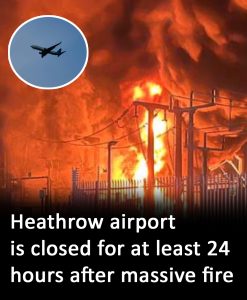London’s Heathrow Airport faced a massive operational crisis after a severe electrical fire led to a complete shutdown of the facility, creating widespread chaos across the travel industry. On Friday, March 21, the airport remained closed for the entire day, as officials struggled to manage the fallout from a power outage that halted flights, stranded passengers, and sent ripple effects through international air traffic.

The source of the disruption was a fire at an external electrical substation responsible for supplying power to Heathrow. In the early hours of the morning, the airport’s official X (formerly Twitter) account posted a stark announcement: “Due to a fire at an electrical substation supplying the airport, Heathrow is experiencing a significant power outage. To maintain the safety of our passengers and colleagues, Heathrow will be closed until 23h59 on 21 March. Passengers are advised not to travel to the airport and should contact their airline for further information. We apologize for the inconvenience.”
Though the fire did not occur within the airport itself, the impact was devastating. According to reports from Sky News, the blaze began in a transformer building in Hayes, a town just over a mile from Heathrow. The fire caused the airport’s main electrical substation to explode, triggering a full-scale power failure and forcing the airport to cease operations. A spokesperson for Heathrow confirmed that disruptions would persist for several days, leaving countless travelers in limbo and airlines scrambling to adjust.
The fire broke out around 11:30 PM on Thursday night. Firefighters worked through the night to contain the flames. While the main fire was under control by morning, parts of the transformer building continued to smolder. Specialist fire crews remained on-site using breathing apparatus to manage residual hot spots and prevent any flare-ups. The London Fire Brigade declared the incident a major emergency, prompting investigations into what exactly caused the electrical failure.
Assistant Commissioner Pat Goulbourne of the London Fire Brigade acknowledged the severity of the incident, stating, “This was a very visible and significant incident, and our firefighters worked tirelessly in challenging conditions to bring the fire under control as swiftly as possible.”
Heathrow Airport typically sees over 200,000 travelers pass through its terminals each day, and today’s closure has thrown the travel plans of hundreds of thousands into disarray. Many passengers had no choice but to cancel or rebook flights, and others found themselves redirected to alternate airports across the UK and Europe. At least 1,357 flights have been either canceled, diverted, or significantly delayed, according to the Daily Mail. Some international flights already en route to Heathrow were diverted mid-flight, but neighboring airports such as Gatwick have quickly reached capacity, compounding the problem.
The cascading effects of the closure are being felt far beyond London. European airports are preparing for a surge in incoming flights that are too far into their journeys to turn around. With so many aircraft seeking alternate landing options, delays and cancellations are expected to continue well into the weekend. Travelers are being urged to check with their airlines before heading to the airport.
While Heathrow does have backup power systems, airport officials admitted that these systems take time to activate and are not capable of instantly restoring full operational capacity. The decision to shut down such a major transportation hub due to a single substation failure has raised serious questions about the airport’s infrastructure resilience and emergency preparedness. Analysts warn that the situation highlights the vulnerability of key travel infrastructure to external factors.
The timing of this incident is particularly unfortunate for Heathrow. The airport recently celebrated a record-breaking January, with over 6.3 million passengers passing through—an increase of more than 5% from the same month last year. It marked the 11th consecutive month during which the airport averaged over 200,000 passengers per day, largely fueled by robust transatlantic travel.
Adding to the chaos, National Rail confirmed that train services to and from Heathrow were also suspended for the entire day. With both air and rail access cut off, passengers were left with few alternatives for reaching the airport or making onward connections. Travelers described scenes of confusion, long lines, and limited support as they tried to rearrange their plans.
The airlines are now faced with the daunting task of rescheduling flights, reallocating crews, and addressing passenger claims for compensation. The financial cost is expected to be substantial, not just for Heathrow and the affected carriers, but for businesses relying on air cargo and logistics as well.
For travelers, the fallout has been deeply frustrating. Social media was flooded with posts from stranded passengers expressing their anger and disappointment. Many voiced concerns over the lack of timely information and assistance from both airlines and the airport itself. Some international travelers found themselves stuck without accommodation or sufficient support.
Authorities are continuing to investigate the root cause of the fire. While there is currently no suggestion of foul play, the fact that a fire at an off-site transformer could shut down one of the world’s busiest airports has prompted calls for a thorough review of Heathrow’s emergency response systems and infrastructure redundancy.
As the airport works to restore power and resume operations, the broader aviation industry is bracing for a prolonged period of disruption. Travelers are advised to remain patient, stay informed, and keep in close contact with their airlines. For now, Heathrow remains closed, and the road to recovery will likely stretch across several days, if not longer, as efforts to restore normal service continue.





